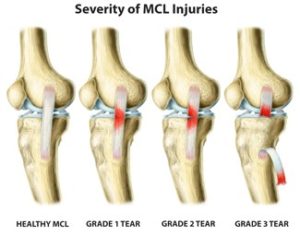What are they?
Ligaments including the Medial Collateral Ligament attach bone to bone. The collateral ligaments are either side of your knee. There are two collateral ligaments;
- Medial Collateral Ligament (MCL) on the inside.
- Lateral Collateral Ligament (LCL) on the outside.
They act to stop your thigh bone (Femur) sliding inwards or outwards on your shin bone (Tibia).
How do they get injured?
Your ligaments are mainly collagen and although they are very strong, an injury can occur.
The usual mechanism of injury is when your foot is planted and you have an impact to the outside of the knee/thigh, or with a rotation of the knee, again with the foot planted. This puts an extreme amount of force through the ligaments and can cause them to stretch, or even rupture. MCL injuries occur more frequently than LCL injuries. It is common for MCL/LCL injuries to occur in combination with ACL, PCL or meniscus injuries.
What does it feel like?
Ligament ruptures can be very painful and often cause immediate swelling at the injured area. Often people feel or hear a ‘pop’ at the time of injury. Pain from an injury to your Medial Collateral Ligament can be felt by touching the inside of your knee joint.
How is it diagnosed?
Your physiotherapist or doctor can diagnose an MCL injury with some simple tests.
How can Back In Action Physiotherapy help?
Some of the most common symptoms of an MCL rupture is significant swelling and difficulty bending the knee. Here at Back in Action Physiotherapy we can work to regain movement with hands-on techniques such as mobilisations and massage and help to maintain and build strength in your leg. You will probably find it difficult to walk on your leg so we will work on getting you back on your feet.

